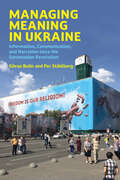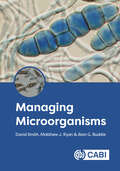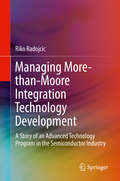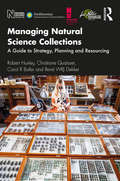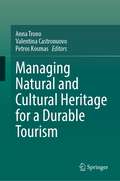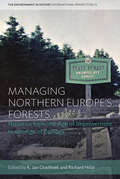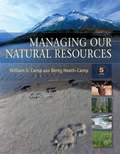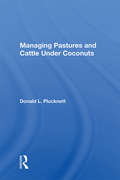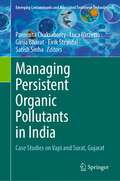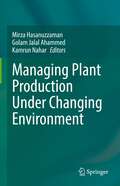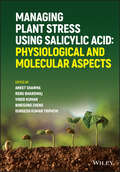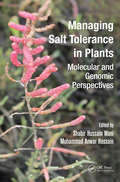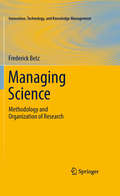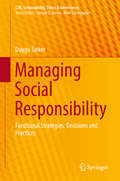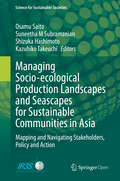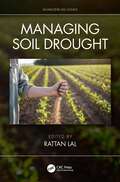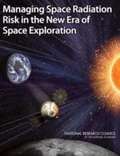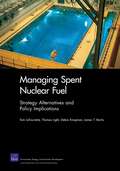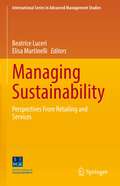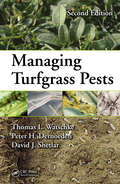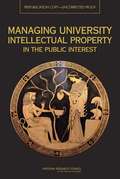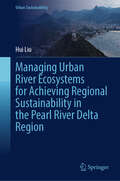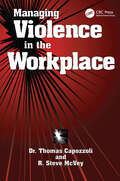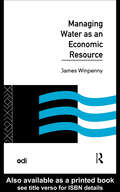- Table View
- List View
Managing Meaning in Ukraine: Information, Communication, and Narration since the Euromaidan Revolution
by Goran Bolin Per StahlbergAn in-depth look at Ukraine&’s attempts to shape how it is perceived by the rest of the world.During times of crisis, competing narratives are often advanced to define what is happening, and the stakes of information management by nations are high. In this timely book, Göran Bolin and Per Ståhlberg examine the fraught intersection of state politics, corporate business, and civil activism to understand the dynamics and importance of meaning management in Ukraine. Drawing on fieldwork inside the country, the authors discuss the forms, agents, and platforms within the complex political and communicative situation and how each articulated and acted upon perceptions of the propaganda threat.Bolin and Ståhlberg focus their analysis on the period between 2013 and 2022, when political tensions, commercial dynamics, and new communication technologies bred novel forms of information management. As they show, entities from governments and governmental administration to commercial actors, entrepreneurs, and activists formed new alliances in order to claim a stake in information policy. Bolin and Ståhlberg also explore how the various agents engaged in information management and strove to manage meaning in communication practice; the communicative tools they took advantage of; and the subsequent consequences for narrative constructions.
Managing Microorganisms
by David Smith Matthew J Ryan Dr Alan BuddieA significant portion of basic and applied life science research requires microorganisms as study specimens. Managing Microorganisms aims to be the standard reference for anyone who works with microorganisms, primarily bacteria and fungi. It is applicable to researchers who maintain their own collections of strains, and those who use one of the many public service culture collections. The book includes coverage of: · methods of preservation and characterization for different groups of microorganisms; · best practice guidelines for culture collection management; · how to protect investment in research with microorganisms; · where to source authenticated microorganisms; · how to store, handle and distribute microorganisms effectively and safely; · the factors to consider in designing a sustainable business plan for a culture collection; · the consideration of health and safety issues, and the wider regulatory environment. Managing Microorganisms is an essential reference for anyone working with microorganisms and culture collections. In addition, it will be of great use for academic researchers and students in applied life sciences, especially those who are involved in sourcing and maintaining reference strains, whilst it also will provide a useful guide for consultants, biotechnologists and other members of bioindustry.
Managing More-than-Moore Integration Technology Development: A Story of an Advanced Technology Program in the Semiconductor Industry
by Riko RadojcicThis book presents the real challenges and experiences of managing an advanced semiconductor technology development and integration program – but using a novelized form. The material is presented in a conversational format through a story that follows a fictional narrator as she grows from an intern to a manager in a (fictional) chip company. The story describes the technology development program from management, engineering and human perspectives, and exposes not only the management and technical issues but also the typical work-life balance challenges experienced by engineers working in the technology industry. Use of a series of realistic and representative vignettes, supported by a set of illustrative cartoon-ish panels, presents the serious management topics in a light and readable way.
Managing Natural Science Collections: A Guide to Strategy, Planning and Resourcing
by Robert Huxley Christiane Quaisser Carol R Butler René WRJ DekkerManaging Natural Science Collections demonstrates the need for consistency and evidence-based decision making in the management of natural science collections, which are becoming increasingly valuable when it comes to addressing societal challenges. Drawing upon the experience of four experts who have managed some of the largest and most diverse collections in the world, the book aims to assist in the making of strategic and operational decisions regarding care, development, access and resource management. Encouraging the reader to consider how collection strategies can be aligned with the mission of their institution and contribute to its vision, the authors also examine ways to deliver a consistent approach that will secure the present and future availability and relevance of collections. Principles of good practice and resource optimisation in an ethical and legal context are provided throughout the book, as well as case studies, sample documents and templates, all of which will be useful for discussion and teaching. Managing Natural Science Collections encourages each reader to consider the different options available to them. As such, it should be essential reading for museum practitioners and other professionals around the world who are involved with any strategic aspect of managing natural science collections. Students of museum studies will also find much to interest them within the pages of this book.
Managing Natural and Cultural Heritage for a Durable Tourism
by Anna Trono Valentina Castronuovo Petros KosmasThis contributed volume offers a wealth of cases that explore the factors and conditions required for heritage tourism to be economically and socially beneficial to local communities without impairing the natural environment, cultural heritage preservation, or sustainability for future generations. The studies presented here comprise an examination of measures which have been and can be implemented to ensure sustainable use of natural and cultural systems, leading to a new concept of tourism that incorporates science and community practices together to create a favorable environment where tourists and locals can experience meaningful interactions and experiences. The book focuses on the role of stakeholders in the development of a new policy regarding the sustainable management of cultural tourism and the possibility of their involvement in the processes governing policy-making. Emphasis is placed on the role and commitment of local and international authorities, including UNESCO, in preserving the world's endangered cultural and natural heritage, as well as the responsibilities of Member States and public and private actors with respect to future conservation challenges.
Managing Northern Europe's Forests: Histories from the Age of Improvement to the Age of Ecology (Environment in History: International Perspectives #12)
by K. Jan Oosthoek Richard HölzlNorthern Europe was, by many accounts, the birthplace of much of modern forestry practice, and for hundreds of years the region’s woodlands have played an outsize role in international relations, economic growth, and the development of national identity. Across eleven chapters, the contributors to this volume survey the histories of state forestry policy in Scandinavia, the Low Countries, Germany, Poland, and Great Britain from the early modern period to the present. Each explores the complex interrelationships of state-building, resource management, knowledge transfer, and trade over a period characterized by ongoing modernization and evolving environmental awareness.
Managing Our Natural Resources
by Betty Heath-Camp William G. CampNew edition of a text that presents a balanced viewpoint of the place of humans in the world as long-term residents. Camp (Virginia Polytechnic Institute and State U.) and Daugherty (Maconaquah High School) present 35 chapters that deal with soil formation, erosion, reclamation, and conservation; water use and improvement; endangered species of wildlife; hunting game animals; fishing; safety in boating, hiking, and other forms of outdoor recreation; conservation farming; land-use planning; construction practices that minimize the impact of exploitation on the environment; energy resources use, abuse, conservation, and alternatives; mineral use and recycling; and career opportunities in each of those diverse fields. Contains b&w illustrations. Annotation c. Book News, Inc., Portland, OR (booknews.com)
Managing Pastures And Cattle Under Coconuts
by Donald L. PlucknettBecause of the long life of a coconut palm--sixty to eighty years--and the relatively wide spacing the plants require, every coconut grower faces the problem of how to manage the land beneath the palms. Many of the small-scale farmers who manage over 90 percent of the 6 million hectares of coconut palms in the world have learned that raising cattle or other livestock under the palms can be profitable, as well as an effective method of controlling weeds. This book reviews current knowledge on this productive farming system, drawing on research results and experiences of successful farmers. Well illustrated with photographs from producing areas, the book includes information on the management of both natural (unimproved) and improved pastures.
Managing Persistent Organic Pollutants in India: Case Studies on Vapi and Surat, Gujarat (Emerging Contaminants and Associated Treatment Technologies)
by Paromita Chakraborty Luca Nizzetto Girija Bharat Eirik Steindal Satish SinhaPersistent Organic Pollutants (POPs) are a class of chemicals that are persistent, bio accumulative and toxic (PBT), which are restricted for use under the Stockholm Convention. They adversely impact the environment, human and animal health. Most of the POPs are semi-volatile organic compounds (SVOCs) and known to have a long-range transport potential and are often deposited in colder climate and found in places away from the regions they are produced. POPs are usually hydrophobic (i.e., “water-hating”) and lipophilic (i.e., “fat-loving”) chemicals, due to which they bind to solids, particularly organic matter, and fatty tissues in both marine and terrestrial environments. As a result, POPs may move up the food chain. This book focuses on determining the sources, fate, analytical techniques of detecting POPs as well as their health impacts. It further dwells on the regulatory aspects, management of POPs, best environmental practices (BEPs), Indian and international case studies, gaps in understanding the regulatory aspects. A few key recommendations for the way forward form the concluding chapters of this book.
Managing Plant Production Under Changing Environment
by Golam Jalal Ahammed Mirza Hasanuzzaman Kamrun NaharThis comprehensive edited volume collects the most recent information with up-to-date citations, on the decrease in plant productivity under climatic changes and its link with global food security. The book emphasis on the crop management practices and recent advancement in the techniques for mitigating the negative effects of climate induced biotic and abiotic stress. It brings together 19 chapters developed by eminent researchers in the area of plant and environmental sciences. Global climate change is increasingly becoming a concern for future of agriculture. High levels of inorganic and organic pollutants and climatic stress adversely affects the sensitive and complex equation of natural resources and ecosystem services. To meet the increased food demand, plant productivity needs to be enhanced, therefore this book fills in the gap and brings together information on the physiological and molecular approaches for improving crop productivity. The book is resourceful reading material for researchers, faculty members, graduate and post graduate students of plant science, agriculture, agronomy, soil science, botany, Molecular biology and environmental science.
Managing Plant Stress Using Salicylic Acid: Physiological and Molecular Aspects
by Renu Bhardwaj Vinod Kumar Durgesh Kumar Tripathi Anket Sharma Bingsong ZhengMANAGING PLANT STRESS USING SALICYLIC ACID Enables readers to understand the ability of salicylic acid in reducing the effects of abiotic stresses in different crop species Salicylic acid is an important plant hormone which acts as a multifunctional molecule and regulates key physiological and biochemical processes in plants. This book highlights the tremendous potential of treating plants with salicylic acid, either prior to or during stress. It focuses on the specific challenges and opportunities related to exogenous application or priming technology, such as the mode of application, new methodologies, and the potential impacts of salicylic acid on the environment. Sample topics covered in the book include: The latest research on the ability of salicylic acid in reducing the effects of abiotic stresses in different crop species The mechanism of action of salicylic acid at the biochemical and molecular level Salicylic acid and its crosstalk with other plant hormones under stressful environments Regulation of abiotic stress by salicylic acid at the gene level The role of salicylic acid on the postharvest physiology of plants This book will be of significant interest to researchers, academics, and scientists working in the field of salicylic acid mediated responses in plants under challenging environments and with abiotic stress tolerance.
Managing Salt Tolerance in Plants: Molecular and Genomic Perspectives
by Mohammad Anwar Hossain Shabir Hussain WaniSalinity stress currently impacts more than 80 million hectares of land worldwide and more arable land is likely to be impacted in the future due to global climate changes. Managing Salt Tolerance in Plants: Molecular and Genomic Perspectives presents detailed molecular and genomic approaches for the development of crop plants tolerant to salinity
Managing Science
by Frederick BetzWhat is science? How is it performed? Is science only a method or is it also an institution? These are questions at the core of Managing Science, a handbook on how scientific research is conducted and its results disseminated. Knowledge creation occurs through scientific research in universities, industrial laboratories, and government agencies. Any knowledge management system needs to promote effective research processes to foster innovation, and, ultimately, to channel that innovation into economic competitiveness and wealth. However, science is a complicated topic. It includes both methodological aspects and organizational aspects, which have traditionally been discussed in isolation from each other. In Managing Science, Frederick Betz presents a holistic approach to science, incorporating both philosophical and practical elements, in a framework that integrates scientific method, content, administration and application. Illustrating all of the key concepts with illustrative case studies (both historical and contemporary, and from a wide spectrum of fields), Betz provides in-depth discussion of the process of science. He addresses the social, organizational, institutional, and infrastructural context through which research projects are designed and their results applied, along the path from experimentation to innovation to commercialization of new products, services, and processes. This practical approach to science is the foundation of today's knowledge-intensive and technology-enabled industries, and positions the management of science within the broader context of knowledge management and its implications for organizations, industries, and regional and national technology management policies. Managing Science will be an essential resource for students in all areas of research, industry scientists and R&D specialists, policymakers and university administrators, and anyone concerned with the application of research to economic growth and development.
Managing Scientists: Leadership Strategies in Research and Development
by Alice M. SapienzaIn today's climate of enormous scientific and technological competition, it is more crucial than ever that scientists' involvement in research and development be managed well.
Managing Social Responsibility: Functional Strategies, Decisions and Practices (CSR, Sustainability, Ethics & Governance)
by Duygu TurkerThis book explores how business organizations incorporate socially responsible approaches into their diverse functional strategies, decisions, and practices. It analyzes the nature and dynamics of each function as well as their specific characteristics in the formulation of sustainable strategies and decisions. As such, the book comprehensively aligns recent approaches on social responsibility and sustainability with real-world practices.By viewing corporate social responsibility (CSR) as the catalyzer of United Nations’ Sustainable Development Goals (SDGs) at the organizational level, this book introduces readers to the latest thinking and best practices towards the accomplishment of those overarching goals of humanity. Cases and examples from production, marketing, finance, accounting, human resources, and all parts of the enterprise make this book a valuable resource for scholars, students, up-and-coming managers and practitioners alike.
Managing Socio-ecological Production Landscapes and Seascapes for Sustainable Communities in Asia: Mapping and Navigating Stakeholders, Policy and Action (Science for Sustainable Societies)
by Osamu Saito Kazuhiko Takeuchi Suneetha M Subramanian Shizuka HashimotoThis open access book presents up-to-date analyses of community-based approaches to sustainable resource management of SEPLS (socio-ecological production landscapes and seascapes) in areas where a harmonious relationship between the natural environment and the people who inhabit it is essential to ensure community and environmental well-being as well as to build resilience in the ecosystems that support this well-being. Understanding SEPLS and the forces of change that can weaken their resilience requires the integration of knowledge across a wide range of academic disciplines as well as from indigenous knowledge and experience. Moreover, given the wide variation in the socio-ecological makeup of SEPLS around the globe, as well as in their political and economic contexts, individual communities will be at the forefront of developing the measures appropriate for their unique circumstances. This in turn requires robust communication systems and broad participatory approaches.Sustainability science (SuS) research is highly integrated, participatory and solutions driven, and as such is well suited to the study of SEPLS. Through case studies, literature reviews and SuS analyses, the book explores various approaches to stakeholder participation, policy development and appropriate action for the future of SEPLS. It provides communities, researchers and decision-makers at various levels with new tools and strategies for exploring scenarios and creating future visions for sustainable societies.
Managing Soil Drought (ISSN)
by Rattan LalGlobal drylands, covering over 40% of Earth’s land surface, are important among worldwide ecoregions and support large human and livestock populations. However, these ecologically sensitive ecoregions are undergoing a rapid transformation resulting from climate change, socioeconomic and political factors, increases in population, and ever-growing demands for goods and services.Managing Soil Drought addresses basic processes and provides specific case studies throughout covering the protection, restoration, and sustainable management goals of global drylands under changing and harsh climatic conditions, including fragile and vulnerable ecosystems. The book is written by numerous researchers, academicians, practitioners, advocates, land managers, and policymakers involved in bringing about transformation in these regions important to human and nature. It includes information on basic strategies of sustainable management of global drylands aimed at improving water use efficiency through choosing appropriate species, developing new varieties, using organic and inorganic amendments, and scaling up innovative farming systems.This volume in the Advances in Soil Sciences series is an essential read for development organizations and policymakers involved in improving crop productivity and sustainability in drought-prone regions; students, researchers, and academicians interested in sustainable management of water resources; and those involved in emerging concepts of regenerative agriculture, agroecology, and conservation agriculture.
Managing Space Radiation Risk in the New Era of Space Exploration
by National Research Council of the National AcademiesAs part of the Vision for Space Exploration (VSE), NASA is planning for humans to revisit the Moon and someday go to Mars. An important consideration in this effort is protection against the exposure to space radiation. That radiation might result in severe long-term health consequences for astronauts on such missions if they are not adequately shielded. To help with these concerns, NASA asked the NRC to further the understanding of the risks of space radiation, to evaluate radiation shielding requirements, and recommend a strategic plan for developing appropriate mitigation capabilities. This book presents an assessment of current knowledge of the radiation environment; an examination of the effects of radiation on biological systems and mission equipment; an analysis of current plans for radiation protection; and a strategy for mitigating the risks to VSE astronauts.
Managing Spent Nuclear Fuel
by Tom Latourrette Thomas Light James T. Bartis Debra KnopmanNuclear power is receiving renewed interest because of its low greenhouse gas emissions. However, if nuclear power is to be sustainable option for the United States, methods for managing spent fuel that meet stringent safety and environmental standards must be implemented. This report examines technical and institutional approaches to spent fuel management and highlights policy implications of pursuing alternative strategies.
Managing Sustainability: Perspectives From Retailing and Services (International Series in Advanced Management Studies)
by Beatrice Luceri Elisa MartinelliCompanies and policy makers are prioritizing environmental, social, and governance goals as part of their strategies. Academic research has started to focus on these issues, but many important matters require deeper investigation and reflection, especially in specific sectors. This book focuses on the sustainability issues within the retailing and services sectors. Starting the discussion around research-knowledge on CSR, the authors discuss the strategic aspects of managing sustainability in retailing and service companies and offer recommendations to effectively manage the marketing levers for sustainability. Readers will benefit from an in-depth analysis of the social responsibility practices of major retailers and their strategies. The authors also take an inside view of CSR by studying the angles of employee perception and job satisfaction, financial performance, and the more recent impact of COVID-19. Using this approach, they highlight the system of relationships existing between stakeholder-related concepts and organizational factors and how they affect sustainability strategy.
Managing Turfgrass Pests
by Thomas L. Watschke Peter H. Dernoeden David J. ShetlarWritten by three of the top professionals in the turfgrass field, Managing Turfgrass Pests, Second Edition brings together hundreds of solutions and best practices to help you manage turfgrass weeds, diseases, and insects more effectively. Since the publication of the bestselling first edition, advances in pest-resistant turfgrass cultivars and pes
Managing University Intellectual Property in the Public Interest
by National Research Council of the National AcademiesThirty years ago federal policy underwent a major change through the Bayh-Dole Act of 1980, which fostered greater uniformity in the way research agencies treat inventions arising from the work they sponsor. Before the Act, if government agencies funded university research, the funding agency retained ownership of the knowledge and technologies that resulted. However, very little federally funded research was actually commercialized. As a result of the Act's passage, patenting and licensing activity from such research has accelerated. Although the system created by the Act has remained stable, it has generated debate about whether it might impede other forms of knowledge transfer. Concerns have also arisen that universities might prioritize commercialization at the expense of their traditional mission to pursue fundamental knowledge--for example, by steering research away from curiosity-driven topics toward applications that could yield financial returns. To address these concerns, the National Research Council convened a committee of experts from universities, industry, foundations, and similar organizations, as well as scholars of the subject, to review experience and evidence of the technology transfer system's effects and to recommend improvements. The present volume summarizes the committee's principal findings and recommendations.
Managing Urban River Ecosystems for Achieving Regional Sustainability in the Pearl River Delta Region (Urban Sustainability)
by Hui LiuThis book provides a systematic understanding of urban river management from the perspective of ecosystem health in the Pearl River Delta region of China, where rapid socio-economic development happens together with exploitation and pollution of the natural environment. Urban rivers, which used to support navigation and provide water resources to humans, now suffer from various kinds of ecosystem degradation and thus create threats to regional sustainability. This book treats the urban river as an ecosystem which closely relates to and interacts with humans and defines urban river ecosystem health as a requirement at three levels: sensorial fitness, living water, and affinity with humans, which emphasizes more on the human-oriented needs. The evolution processes of urban river ecosystem health protection can generally be divided into four phases, demonstrating the relationships between human activities and UREH status as simple balance, uncontrolled imbalance, continuous interlocking, and stable harmony. The relationships between typical urban rivers and humans in the Pearl River Delta region, China, are then analyzed on both regional and local scales and from lateral, time-longitudinal, and spatial dimensions. Intensive human activities, together with the intrinsic complex and high-density river network, result in deteriorating water quality, changing hydrological conditions, and damaging the river ecosystem in this region. From the perspective of political ecology, various actors in urban river management include governmental agencies, business, multilateral institutions, ENGOs, and grassroots actors, whose unequal power relations vary over time and space, causing conflicts as well as coordination. Especially, different governmental agencies are engaged, resulting into overlap and gap among their functions as well as spatial discrepancy. River Chief System, as a new practice of urban river management, has strengthened the collaboration effect and got success in river pollution control. The spatial scale effect of human activities on urban river water quality is examined, implying the necessity of adopting a unified management strategy at the buffer zone scale to protect and restore urban river ecosystem health. The target audience of this book includes postgraduate students and researchers who have research interests in, as well as government officers, whose routine is related to water management.
Managing Violence in the Workplace
by Thomas K. Capozzoli R. Steve McVeyManaging Violence in the Workplace is a prescription that contains many lists of "do's" and "don'ts" and "how to's" for proactive and reactive responses to workplace violence. The authors have analyzed numerous incidents in the workplace and constructed "how to" guidelines. Be prepared for managing workplace violence. Develop procedures to reduce the potential for violence, create contingency plans, fulfill your legal and moral obligation to employees and the public, reduce your company's liability, and provide a safer environment for all. Who can benefit from Managing Violence in the Workplace? Any organizational executive, risk manager, security, or human resource professional... anyone working to create a comprehensive, organizational program for response to potential and actual incidents of workplace violence.
Managing Water as an Economic Resource (Development Policy Studies Series)
by James WinpennyWater, already a scarce resource, is treated as though it were plentiful and free. The task of supplying enough water of the required quality to growing populations is straining authorities and governments to the limit as the economic and environmental costs of new supply sources escalate and wasteful supply, delivery and consumption systems persist. Managing Water as an Economic Resource argues that the root of the crisis is the failure of suppliers and consumers to treat water as a scarce commodity with an economic value. James Winpenny evaluates policies for the improved management of existing demand, and draws on case studies from different countries as he discusses how policies could be implemented to treat water as an economic good conferring major economic, financial and environmental benefits.
